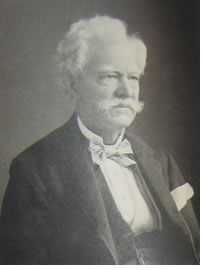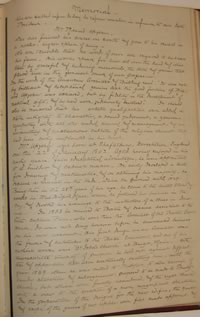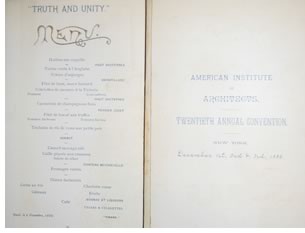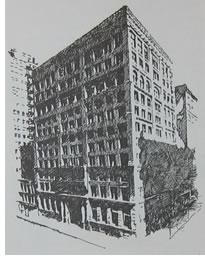

by Tony P. Wrenn, Hon. AIA The AIA’s first organizational decade, 1857-66, was
truncated by four years of Civil War into a decade of six years.
Yet, during those missing four years, one of the AIA’s
founding architects, Thomas U. Walter, completed his design and
construction of the iconic U.S. Capitol dome, which symbolized
then, and now, the supremacy of the Union. During its second decade, 1867-’76, the AIA attracted
members from beyond the New York, Boston, and Philadelphia area,
finding favor in the Midwest and upper South; held the first AIA
convention and published its proceedings; and oversaw the
establishment of the first AIA chapter and the first collegiate
schools of architecture. At the end of that decade, in 1876,
leadership passed from Richard Upjohn, in whose New York office the
Institute was founded in 1857, to Walter. Those two, with another
founder, Richard Morris Hunt, who followed Walter as president, led
the AIA to the threshold of the 20th century. As unlikely as it might seem that the AIA would survive its
earliest years without the perseverance of these three founders, it
is equally unlikely that it could have orchestrated or sustained
its Golden Age of the late 19th and early 20th centuries without
two men who became members during this third decade: Charles Follen
McKim, of New York, who became a Fellow in 1877, and Glenn Brown,
of Washington, D.C., who became a member in 1882. McKim, born in 1847, grew up in rural Pennsylvania, attended
Harvard for a year, then studied in Paris at the Ecole des
Beaux-Arts. He returned to this country in 1870 to work in the
office of Henry Hobson Richardson, who had become an AIA member in
1866. McKim founded his own firm in New York in 1872, which became
McKim, Mead and White, probably the best-known American
architecture firm of the 19th and 20th centuries. McKim moved, once
he was a member, almost immediately into leadership, being elected
AIA secretary for the term of 1877-1878. In the 20th century, he
would become AIA president. Brown, born in 1854 in Fauquier County, Va., spent much of his
childhood at his grandfather’s house, Rose Hill, in Caswell
County, N.C. His grandfather, Bedford Brown, a U.S. senator from
North Carolina, had opposed North Carolina’s secession from
the Union, though his father, Bedford Brown Jr., served as a
surgeon in the Confederate Army. After studying architecture at
MIT, Glenn Brown too became associated with Henry Hobson
Richardson—through Norcross Brothers in Worcester, Mass.,
Richardson’s master builders, where he served as draftsman and
paymaster. Brown opened his own office in Washington, D.C., in
1880. Both McKim and Brown survived into the Institute’s sixth
decade. McKim died in 1909 and, although Brown survived until 1932,
his AIA leadership ended in 1913 with an AIA reorganization. How
incredible it would have been to listen in on the conversational
flow of ideas when, during its third decade, these five, Upjohn,
Walter, Hunt, McKim, and Brown—often together with others who
were then members and whose names we recognize instantly
today—came together in AIA meetings and conventions. The
existing record indicates that architecture and the fledgling
organization seem never to have been far from their minds. Founders remembered Other founders would die during the decade. Of R. G. Hatfield,
who was AIA treasurer from 1860 to his death in Feb. 1879, the
trustees “gratefully call to mind the fact that all Mr.
Hatfield’s intercourse with its members has been marked by
uniform courtesy, and that his temperate counsel and consideration
had earned from them unqualified regard and respect.” Of all
the decade’s memorial statements, none is more touching than
that for Henry Fernback, who became a member in 1866 and died in
November 1883. Emlen L. Littell, who became a member in 1860, and
served as AIA secretary from 1862-64, wrote of him: “It is
rare indeed to find a man combining, as he did, such large
proportions of wit, kindness, energy, integrity & intellect. It
is rare to find an architect holding ground among the foremost of
his profession & practicing it actively and widely for so many
years having, as he had, not an enemy, but hosts of friends among
his employees, his clients and his professional friends. “He was devoted to his art, & his help in all matters
which tended to elevate it & further its higher aims, with his
ready sympathy for its practioneers, & especially for the
members of this Institute, were marked features in a character
illuminated by the genial glow of a warm heart.” These statements represent perhaps the greatest effect of the
AIA on the profession, for, even if it were only a
“gentleman’s club,” it changed the relations of
those gentlemen one to the other. Reminiscing at the 11th
Convention on Oct 18, 1877, E. C. Cabot, president of the Boston
Society of Architects, an AIA chapter, noted “Thirty years go,
when I commenced practice in this city, there were but half a dozen
architects, and several of these had been bred as engineers. There
was but little sympathy between them, their designs were carefully
guarded from each other, and their libraries kept locked. We had
few books of reference, and photographs were almost unknown. Twenty
years later ... About 50 assembled, some articles of association
were drawn up, a portion of those present signed them, and formed
the Boston Society of Architects ... The result of all this has
been to promote amongst us the most friendly professional
relations. As artists we cannot live without sympathy, and through
the earnest love of our work, and this cordial intercourse, we must
look for the elevation of our professional practice.” In fellowship, all for one
… The move westward Membership, which had long since included mid-Americans, reached
the West Coast in 1870 when Augustus Laver of San Francisco was
elected to Fellowship. Laver actively recruited new members,
writing in February 1878 about forming a chapter. At first, it was
to be a Pacific Coast chapter, but when it gave its first chapter
report, at the 16th Convention, October 25-26, 1882, in Cincinnati,
it was as the “San Francisco Chapter.” The American
Institute of Architects finally reached from coast to coast. Yet there were those who felt ignored and deprived of positions
of leadership. In 1884, some 100 architects from 14 Midwest states
met in Chicago and organized the Western Association of Architects
(WAA). Their’s was to be a classless membership, all were to
be Fellows, each a “professional person whose sole occupation
is to supply all data preliminary to the material, construction and
completion of a building and to exercise administrative control
over contractors supplying material and labor ... and the
arbitration of contractors stipulating terms of obligation and
fulfillment between proprietor and contractor.” At heart, the good of the
profession Up, up, and away Jenney had studied in Paris, choosing engineering at the Ecole
Centrale des Arts et des Manufactures, and not architecture in the
Ecole des Beaux-Arts. In spite of this, and in recognition of his
professional accomplishments, the AIA advanced him from Associate
to Fellow in 1886, one small step in dealing with competing
organizations and highrise buildings in its tricky architectural
future. Both would figure prominently in the AIA’s fourth
decade.
 Upjohn died
Aug. 17, 1878, having survived barely into the Institute’s
third decade. Walter, in turn, barely survived into the fourth
decade, dying on Oct. 30, 1887. Hunt almost survived through the
fourth decade, dying July 31, 1895. These three, adult and
even-handed, yet ready to listen and open to ideas, must be given
credit for maturing the small—often uncertain of
direction—AIA.
Upjohn died
Aug. 17, 1878, having survived barely into the Institute’s
third decade. Walter, in turn, barely survived into the fourth
decade, dying on Oct. 30, 1887. Hunt almost survived through the
fourth decade, dying July 31, 1895. These three, adult and
even-handed, yet ready to listen and open to ideas, must be given
credit for maturing the small—often uncertain of
direction—AIA.
Upjohn’s memorial, after his death August 17, 1878, was
entered in the Minutes of the Trustees in several black-bordered
pages and read by AIA President Walter at the 12th Convention in
New York on November 13, 1878. Upjohn’s early life was noted,
as was his arrival in New York where he designed Trinity Church
(1841-46). “In the preparation of the designs for the new
edifice, the power and scope of the genius of Mr. Upjohn were first
made apparent, and from that time the success of his professional
career was assured. He dreamt,” Walter noted, “not of a
perishable home, who thus could build ... His works speak for him
all over the land and illustrate by graceful and enduring memorials
the taste and genius that placed him in the foremost rank of our
profession.” Upjohn’s activities, Walter said, had raised “the social
and moral standard of the Institute ... placing it in the advance
position it now occupies in the public estimation ... During all
these years he was untiring in his efforts to establish good
fellowship throughout the profession, to raise the standard of
practice, and to promote the progress of our art.”
Upjohn’s activities, Walter said, had raised “the social
and moral standard of the Institute ... placing it in the advance
position it now occupies in the public estimation ... During all
these years he was untiring in his efforts to establish good
fellowship throughout the profession, to raise the standard of
practice, and to promote the progress of our art.”
The decade was not an easy one economically. The absence of
work or personal tragedy often brought petitions to the Trustees
from members who could not pay their dues. One member, from
Cleveland, wrote on December 29, 1877, “pleading for an
extension of time in the payment of dues owing to prolonged
sickness in his family followed by the death of three of his
children.” The Secretary moved, and the Trustees approved
unanimously that “the sympathy of the Trustees by conveyed ...
that an indefinite extension of time for the payment of dues by
granted ... and that his name be retained on the rolls.” One
future president of the AIA was reported that year as delinquent
and, more shocking, as not having abided by the Bylaws in not
having “forwarded credentials of his professional work.”
Nevertheless both were overlooked—after all, three trustees,
including the AIA secretary, knew and endorsed him—and he was
advanced to Fellowship. Though the policy had already been breached
in that that member’s name was on the record, others were
protected for the trustees’ voted that the “list of
delinquents not be read into the minutes.” When, at the
February 15, 1877, trustees meeting, the treasurer reported a long
list of delinquents, a blank page was left in the minute book where
the secretary wrote in pencil “don’t insert names until
it is seen who pays.” Members experiencing difficulty were not
to be embarrassed in perpetuity. As the AIA
established contacts and its activities were reported in the press,
it received letters from all parts of the country, Canada, and
abroad, some 200 the trustees reported in 1884. The secretary sent
such documents as had been adopted by that time—a standard
contract, a schedule of charges, a pamphlet on competitions, the
constitution and by-laws, and perhaps convention proceedings. In
1881, when a letter came from a foreign architect asking for
information with a view to possible emigration, President Upjohn
noted caustically that it was not “one of the projects of the
Inst to form an Immigration Society.” Trustee Hatfield,
however, thought such letters should not be ignored, but be
referred to architects who had written the AIA seeking “first
class assistance.”
As the AIA
established contacts and its activities were reported in the press,
it received letters from all parts of the country, Canada, and
abroad, some 200 the trustees reported in 1884. The secretary sent
such documents as had been adopted by that time—a standard
contract, a schedule of charges, a pamphlet on competitions, the
constitution and by-laws, and perhaps convention proceedings. In
1881, when a letter came from a foreign architect asking for
information with a view to possible emigration, President Upjohn
noted caustically that it was not “one of the projects of the
Inst to form an Immigration Society.” Trustee Hatfield,
however, thought such letters should not be ignored, but be
referred to architects who had written the AIA seeking “first
class assistance.”
At the April 16, 1884, meeting, the St. Louis Chapter was
admitted, bringing the number of chapters to 11, and “papers
relating to the Bartoldi Statue of Liberty” were examined and
“laid over to the next meeting.” The Bartoldi Statue
Committee requested funds and after prolonged discussion at its
June 20 meeting. “It was moved, seconded, and voted, that in
view of the low state of the funds in the Treasury of the
Institute, that the request for funds be laid on the table.”
The AIA was not to be denied participation, however, for founder
and member Richard Morris Hunt designed the pedestal on which the
Statue stands. Many WAA
members were also members of the AIA, creating a problem that the
AIA would have to solve in its next decade or face stiff
organizational competition. Almost immediately, the WAA formed a
Southern Chapter and actively sought members in the South, an area
then sparsely represented in the AIA; offering immediate
membership, without question, to anyone already an AIA member.
Many WAA
members were also members of the AIA, creating a problem that the
AIA would have to solve in its next decade or face stiff
organizational competition. Almost immediately, the WAA formed a
Southern Chapter and actively sought members in the South, an area
then sparsely represented in the AIA; offering immediate
membership, without question, to anyone already an AIA member.
A. J. Bloor of New York, who had become an AIA member in 1861
and served 12 years as its secretary, attended the founding
convention and the second, which he described to the 20th AIA
Convention in 1886. He told of the election of a woman, Louise
Bethune of Buffalo, N.Y., to the WAA and reported “In private,
I was asked my views on the question of her admittance, and, as an
individual, I expressed myself in favor of it.” He was less
approving of Louis Sullivan, who “read an original and
charming paper of fine literary quality, (though personally I do
not altogether agree with all his deductions), on
‘Characteristics and Tendencies of American
Architecture.” Bloor concluded “The impression made upon
me during the performance of the mission you entrusted to me is
that the Association, equally with the Institute, has the good of
our art and of its professors at heart, and that it is our duty to
work cordially with it. The more closely we are united, the
speedier will be the realization of our common objects. Those who
are not with us are against us, and we have worked too long and too
hard to see complacency the fruit of what we have sown scattered
abroad.”
William LeBaron Jenney, of Chicago, who had become an AIA
member in 1872, participated actively in the migration of the
Institute westward and, in many ways, presaged its future as well,
by participating in organizing the WAA to challenge the national
supremacy of the AIA. The character of his architecture embodied in
the design and construction of his Home Insurance Building in
Chicago, 1884-85, would eventually challenge even the then
prevailing concept of building. Of skeletal construction, the Home
Insurance Building, initially 9 stories high, was raised to 11 in
1891. It has long been touted as the first “skyscraper,”
but there are other claimants. One is the New York Produce
Exchange, designed by George B. Post, who became a member of the
AIA in 1860. The Exchange, with a plaque that identified it as the
first skyscraper, was earlier, 1882-84, than Jenney’s building
in Chicago.
Copyright 2005 The
American Institute of Architects. All rights reserved. Home Page ![]()

